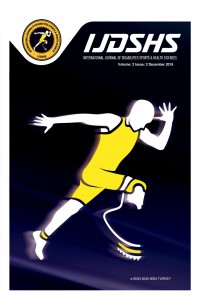Abstract
References
- Francisko, E., & Puspitawati, I. D. (2013). Perbedaan Metode Konvensional Dan Metode Bermain Terhadap Partisipasi Belajar Penjas. Jurnal Pendidikan Dan Pembelajaran, 2(11), 3–15. https://doi.org/10.1017/CBO9781107415324.004
- Garrett, P., & Shortall, T. (2002). Learners’ evaluations of teacher-fronted and student-centred classroom activities. Language Teaching Research, 6(1), 25–57. https://doi.org/10.1191/1362168802lr096oa
- Kemmis, S., & McTaggart, R. (2005). Participatory action research: Communicative action and the public sphere. In Sage Publications Ltd. https://doi.org/10.1080/09650790600975593
- Moriña, A. (2017). Inclusive education in higher education: challenges and opportunities. European Journal of Special Needs Education, 32(1), 3–17. https://doi.org/10.1080/08856257.2016.1254964
- Musfiqon, & Nurdyansyah. (2015). Pendekatan Pembelajaran Saintifik. Sidoarjo: Nizamia Learning Center Sidoarjo.
- Nurdyansyah, & Fahyuni, E. F. (2016). Inovasi Model Pembelajaran Sesuai Kurikulum 2013. Sidoarjo: Nizamia Learning Center Sidoarjo. Purwanto, N. (2012). Prinsip-prinsip dan teknik evaluasi pengajaran.
- Bandung: PT Remaja Rosdakarya. Sanjaya, W. (2009). Penelitian Tindakan Kelas. Bandung: Kencana Prenada Media Group.
- Sedlak, P., Komarkova, J., & Piverkova, A. (2010). Spatial analyses help to find movement barriers for physically impaired people in the city environment - Case study of pardubice, Czech Republic. WSEAS Transactions on Information Science and Applications, 7(1), 122–131.
- Septiawan, F. (2018). Pelaksanaan Pembelajaran Akuatik untuk Anak Cerebral Palsy di SLB N Pembina Yogyakarta. Widia Ortodidaktika, 7(5), 438–448.
- Verschuren, O., Wiart, L., Hermans, D., & Ketelaar, M. (2012). Identification of facilitators and barriers to physical activity in children and adolescents with cerebral palsy. Journal of Pediatrics, 161(3), 488–494. https://doi.org/10.1016/j.jpeds.2012.02.042
- Wieder, S., & Greenspan, S. I. (2003). Climbing the symbolic ladder in the DIR model through floor time/interactive play. Autism, 7(4), 425–435. https://doi.org/10.1177/1362361303007004008
A Floor Time Approach to Improve Learning Outcomes of the Body Roll to the Side in Adaptive Physical Education Learning: Classroom Action Research Study on Two Cerebral Palsy Students
Abstract
This study aims to analyze the Floor Time Approach to Improve the Learning Outcomes of Rollers to the Side in Adaptive Physical Education Learning for Cerebral Palsy Students . This research is a class action research using the Kemmis & Mc Taggart model namely ). The study was conducted in 2 cycles, while each cycle contained four components ( planning, action, observation, and reflection ) . The participants of this study were two students in class I cerebral palsy (age) at State Special School (SLBN) 1 Bantul , Indonesia . The instruments used in this study were side roll learning test results, observation of student participation guidelines, teacher performance observation guidelines, and learning process documentation. Data analysis uses three stages and is accompanied by the calculation of indicators of success. The results showed the implementation of the floor time approach in improving the learning process especially in adaptive physical education subjects and other subjects in general. This also affects the ability to roll aside the first grade cerebral palsy students in SLBN 1 Bantul which also increased. The research was carried out in 2 cycles. The results of the first cycle score have shown an increase in ability but have not been able to reach the KKM. The next step is to take action in cycle II. The results of the acquisition of scores in the second cycle. The results of the acquisition score in the second cycle has increased, of the 2 subjects in 8 and 9 years old (M= 8.5) can reach the KKM that is 75%. Angga obtained a score of 76 , 67 %, “T” obtained a score of 86.67%. The conclusion of this study is that the floor time approach can be used to improve learning outcomes of side roll in adaptive physical education learning for cerebral palsy students.The contribution of this study is that the teacher or reader can adopt the learning design of cerebral palsy children with a floor time approach to adaptive physical education in this study.
Keywords
References
- Francisko, E., & Puspitawati, I. D. (2013). Perbedaan Metode Konvensional Dan Metode Bermain Terhadap Partisipasi Belajar Penjas. Jurnal Pendidikan Dan Pembelajaran, 2(11), 3–15. https://doi.org/10.1017/CBO9781107415324.004
- Garrett, P., & Shortall, T. (2002). Learners’ evaluations of teacher-fronted and student-centred classroom activities. Language Teaching Research, 6(1), 25–57. https://doi.org/10.1191/1362168802lr096oa
- Kemmis, S., & McTaggart, R. (2005). Participatory action research: Communicative action and the public sphere. In Sage Publications Ltd. https://doi.org/10.1080/09650790600975593
- Moriña, A. (2017). Inclusive education in higher education: challenges and opportunities. European Journal of Special Needs Education, 32(1), 3–17. https://doi.org/10.1080/08856257.2016.1254964
- Musfiqon, & Nurdyansyah. (2015). Pendekatan Pembelajaran Saintifik. Sidoarjo: Nizamia Learning Center Sidoarjo.
- Nurdyansyah, & Fahyuni, E. F. (2016). Inovasi Model Pembelajaran Sesuai Kurikulum 2013. Sidoarjo: Nizamia Learning Center Sidoarjo. Purwanto, N. (2012). Prinsip-prinsip dan teknik evaluasi pengajaran.
- Bandung: PT Remaja Rosdakarya. Sanjaya, W. (2009). Penelitian Tindakan Kelas. Bandung: Kencana Prenada Media Group.
- Sedlak, P., Komarkova, J., & Piverkova, A. (2010). Spatial analyses help to find movement barriers for physically impaired people in the city environment - Case study of pardubice, Czech Republic. WSEAS Transactions on Information Science and Applications, 7(1), 122–131.
- Septiawan, F. (2018). Pelaksanaan Pembelajaran Akuatik untuk Anak Cerebral Palsy di SLB N Pembina Yogyakarta. Widia Ortodidaktika, 7(5), 438–448.
- Verschuren, O., Wiart, L., Hermans, D., & Ketelaar, M. (2012). Identification of facilitators and barriers to physical activity in children and adolescents with cerebral palsy. Journal of Pediatrics, 161(3), 488–494. https://doi.org/10.1016/j.jpeds.2012.02.042
- Wieder, S., & Greenspan, S. I. (2003). Climbing the symbolic ladder in the DIR model through floor time/interactive play. Autism, 7(4), 425–435. https://doi.org/10.1177/1362361303007004008
Details
| Primary Language | English |
|---|---|
| Subjects | Sports Medicine |
| Journal Section | Articles |
| Authors | |
| Publication Date | December 23, 2019 |
| Published in Issue | Year 2019 Volume: 2 Issue: 2 |

